This chapter begins with a description of the male and female reproductive systems followed by a section on sex determination. A good knowledge of the anatomy of these systems has allowed the development of a unique technique for semen collection and insemination adapted specifically to geese (see section on Artificial Insemination). This is slightly different from the technique used for most other avian species, e.g. Gallus gallus.
MALE REPRODUCTIVE SYSTEM
FIGURE 12. Reproductive organs of the gander
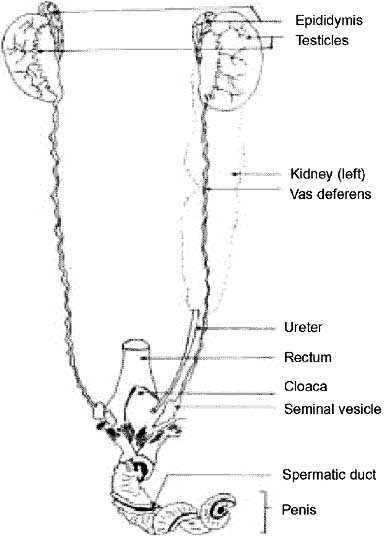
(Source: Pénichon, 1990)
The reproductive system of the gander consists of three distinct parts:
The testicles
There are two bean-shaped testicles inside the body cavity which produce both spermatozoa and male hormones. They are highly vascularized and change in size and position according to whether the gander is sexually active or not. The age of sexual maturity for ganders is directly related to their lighting programme. However, spermatozoa production does not usually begin until the ganders are at least 30 weeks of age. From the testicles the spermatozoa move to the epididymis.
The vas deferens
These (there are two) follow the urethras and transport the spermatozoa from the testicles and the epididymis to the copulatory organ. Their apparent length is 15 cm, but they have numerous bends and twists and in fact measure more than 30 cm. The vas deferenes are the location of spermatozoa maturation and storage. They terminate at the seminal vesicles located in the cloaca wall.
The copulative organ
Contrary to the rooster, Gallus gallus, the copulatory organ of the gander is very well developed. It is invaginated, spiral-like and is about 15 cm in length. A spermatic furrow runs along the entire length of the organ and transports the semen after ejaculation.
FEMALE REPRODUCTIVE SYSTEM
FIGURE 13. Reproductive organs of the goose
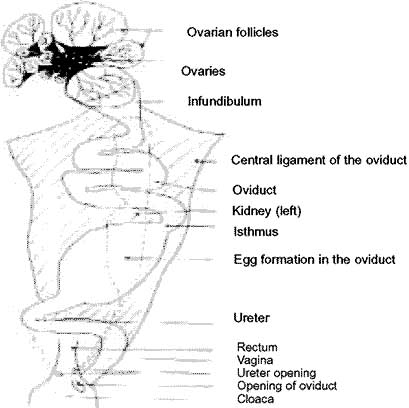
(Source: Pénichon, 1990)
Like most other birds, the female goose possesses a unique reproductive system located on the left side of its abdomen. The functions of the reproductive system are to produce, fertilise and mature the oocyte.
Once copulation or insemination has taken place, the oviduct plays a role in spermatozoa storage. When a mature oocyte is released on an ovulated yolk, it is picked up by the infundibulum where fertilisation occurs. The egg white or albumen is then secreted primarily in the magnum. The egg then moves to the isthmus where the shell membranes are formed. In the uterus or shell gland, water and the thin albumen are added and the shell is formed. The vagina has a muscular component that helps to expel the egg through the cloaca.
SEX DETERMINATION
When selecting geese for breeding, the sex of each goose must be determined. With breeds such as the Pilgrim which are autosexing by feather colour (adult males are white and adult females are grey), this is simple. For Chinese breeds of geese, the sexes are readily identifiable by the size of their knob, with those of mature males being larger, more prominent and associated with a larger head. Most strains of Embden and some strains of White Italian can be sexed by down colour as goslings, since the males are lighter in colour than the females. After a few weeks of age, these sex differences in down colour disappear, so sex identification of individual goslings must be done at hatching.
Most other breeds of geese lack distinctive secondary sex characteristics and therefore to sex geese of these breeds it is necessary to examine their sex organs. However, even though geese can be sexed by examination of their sex organs, either as gosling or as adults, it is recommended that they be sexed as goslings at hatching. When this is done, a good system of identification is required (see Geese Identification) to ensure that individual geese can be identified throughout their life. The sexing of goslings at hatching also allows for the disposal of surplus males, not required for breeding, at market age. It is recommended that one male be kept for every three females to ensure there are enough males to make up breeder groups with a ratio of one male to four or five females.
Vent sexing of day old goslings is not difficult and a little practice will make the sexing of day-old goslings a fairly easy task. Figure 14 shows how to hold a gosling, which is the same way to hold a duckling, so as to expose its reproductive organs. This process of exposing reproductive organs should take place under a strong light in order to better identify the sex organ. Figure 15 shows the male and female reproductive organs of goslings much enlarged.
FIGURE 14. Method of holding day-old goslings to expose their reproductive organs
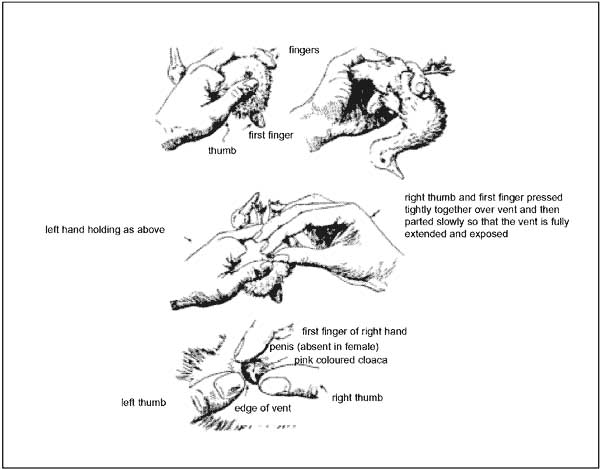
(Source: Hunter & Scholes)
FIGURE 15. Male (left) and female (right) reproductive organs of day-old goslings (much enlarged)

(Source: Ontario Ministry of Agriculture and Food)
If geese are to be sexed as adults, the recommended procedure is that each goose be caught, lifted by its neck and laid on its back, either on a table or over the operator's bent knee, with the tail pointed away from the operator as shown in Figure 16.
FIGURE 16. Method of holding adult geese for sexing
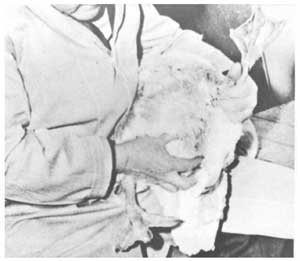
(Source: Ontario Ministry of Agriculture and Food)
The tail portion of the bird should be out over the edge of the table or over the operator's knee so it can be bent downwards easily. The operator then inserts his/her index finger (sometimes it helps to have a little Vaseline on it) into the cloaca about 1.0 to 1.5 cm and moves it around in a circular manner several times to enlarge and relax the sphincter muscle which closes the opening. Next, pressure is applied both directly below and to the side of the vent in order to expose the sex organ as shown in Figure 17. In some birds the male organ is somewhat difficult to unsheathe, particularly if the birds are either immature or not in semen production. For this reason an inexperienced sexer can easily mistake a male for a female if, after slight pressure, the phallus is not exposed. Only the presence of a female genital eminence will positively identify a female.
FIGURE 17. Exposed reproductive organs of mature male (left) and female (right)
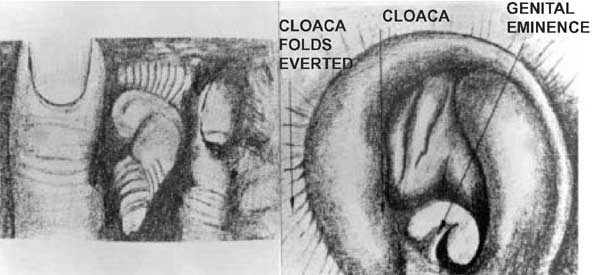
(Source: Ontario Ministry of Agriculture and Food)